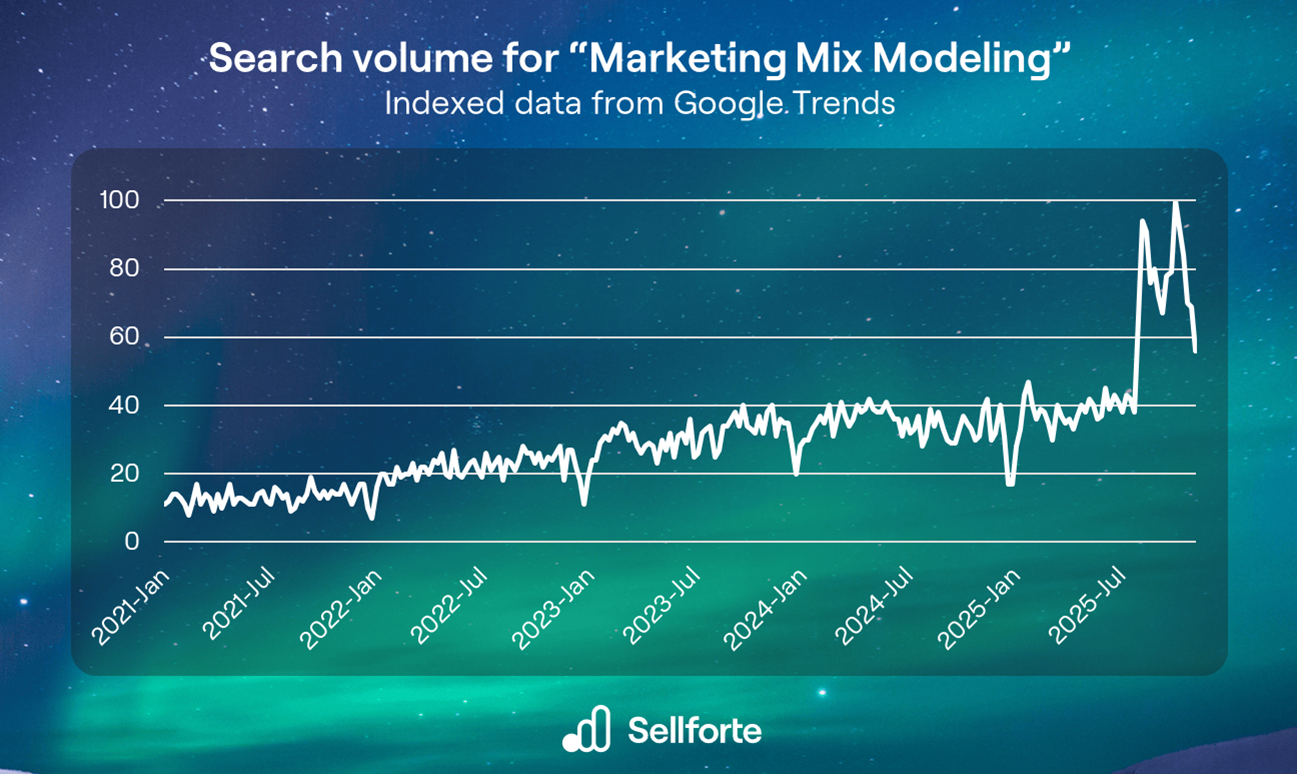Demand for Marketing Mix Modeling (MMM) Accelerating as Marketers Turn Their Attention to 2026
Latest data from Google Trends shows a surge in interest towards Marketing Mix Modeling (MMM), starting in 2025 August. After years of gradual adoption, MMM is breaking into mainstream attention.
When you zoom out, this shift makes sense. As marketers start planning for 2026, they are facing a landscape where attribution tools alone no longer provide the clarity required for media spend optimization. The industry is searching for better answers, and MMM has emerged as the most credible solution for measuring the true incremental revenue impact of media.
-png.png?width=900&height=509&name=Demand%20for%20MMM%20(1)-png.png)
In this blog, we'll discuss the three forces driving rapid acceleration in interest towards MMM.
Google Trends data: Interest Towards MMM is Increasing
Before diving deeper into the drivers behind recent increase in MMM interest, let's look at the actual data.
The chart below shows Google Trends search volume data for "Marketing Mix Modeling".

In the chart, we can see that interest towards MMM has gradually increased over time. From early 2021, the search volume increase roughly by +300% to mid 2025. In mid 2025, something happened. Interest spiked within weeks by more than +200%.
Let's next discuss the drivers behind the long-term gradual increase and short-time explosion in demand for Marketing Mix Modeling.
1. Google Meridian Has Expanded MMM’s Reach
Let's first look at the ecosystem players.
There are three big proponents making waves for Marketing Mix Modeling: Google, Meta and TikTok. All of them have incentive to promote MMM, because it will show the true ROI of their media, which is often better than what last-click or attribution methods are showing. As an example, you can check these article:
- How to Measure the True Effectiveness of TikTok Ads?
- How to measure Meta correctly? GA4 vs. MTA vs. MMM
For Google, the biggest benefactor from MMM is Youtube, which is severely under-measured by attribution.
The most externally visible efforts to promote MMM are currently done by Google with Google Meridian, the open-source library for MMM. By introducing Meridian and championing MMM at global scale, Google is effectively educating the market about MMM and its benefits.
This benefits all MMM vendors, including Sellforte, tremendously. Prospects who have tried or heard Meridian have a clearer understanding of MMM and what it can do.
2. MMM has Finally Become Relevant for Ecommerce and DTC brands
One of the most significant changes this year is the shift in who is adopting MMM. Historically, MMM was used primarily by large omnichannel advertisers. Ecommerce and DTC brands have mostly stuck with attribution until now, because traditional MMM has only provided channel-level insights, such as Google Performance Max vs. Meta Advantage+.
Channel-level insights have not been helpful, because ecommerce and DTC brands optimize media on the campaign and ad set level. If an MMM vendor tells an ecommerce business to increase Meta Prospecting spend, there will immediately be a question: "Which campaigns and ad set?" Traditional MMM can't answer this question.
Today, technology has changed. Next-generation MMM solutions, such as Sellforte now operate at the level where ecommerce brands make real decisions, providing bid value recommendations for each campaign and ad set.
In our own data at Sellforte, the increase in inbound demand from ecommerce and DTC brands is clear. They are now at the forefront of MMM adoption because, finally, MMM speaks the language of digital performance marketing.
3. Agentic MMM is Lowering the Barrier to Insights
A quiet revolution is happening in how marketers interact with analytics tools. Dashboards are giving way to conversational interfaces. Instead of navigating complex optimization tools, users can simply ask an AI Agent the business question they care about.
This shift is especially powerful in MMM, where deploying and extracting insights traditionally required specialized expertise.
With Agentic MMM, a marketer can ask a Media Planner Agent: “What’s the optimal budget allocation for the next four weeks?” The marketer gets a clear, actionable recommendation, without spending time in setting up scenarios in optimization tools.
This new interaction model removes friction. It makes MMM usable every day, by every marketer, not just analysts.
A turning point for the industry
As marketers prepare for 2026, the demand for measurement that is both accurate and actionable is higher than ever. MMM has stepped into that gap with new relevance, new capabilities, and a new user experience.
And this is just the beginning. In 2026, Sellforte is pushing the boundaries of what's possible and introducing full self-drive to media optimization and buying, increasing the value of MMM even further.
Learn more by booking a demo with Sellforte.
Authors
Lauri Potka is the Chief Operating Officer at Sellforte, with over 15 years of experience in Marketing Mix Modeling, marketing measurement, and media spend optimization. Before joining Sellforte, he worked as a management consultant at the Boston Consulting Group, advising some of the world’s largest advertisers on data-driven marketing optimization. Follow Lauri in LinkedIn, where he is one of the leading voices in MMM and marketing measurement.
You May Also Like
These Related Stories
What is Causal Attribution in Marketing?

How Performance Marketers Use MMM to Maximize Campaign ROI

